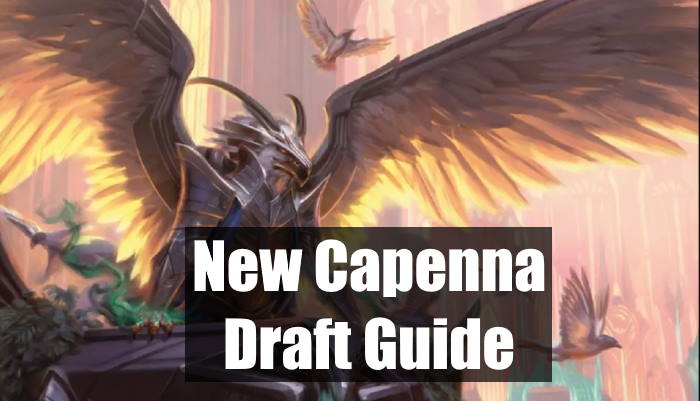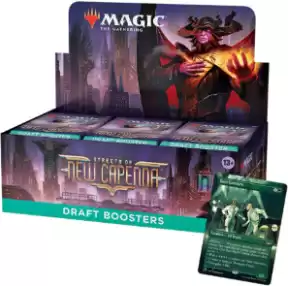Streets of New Capenna is right around the corner. With the set’s release fastly approaching on MTG Arena and in paper soon we’ll have a brand new Limited format to play. While Kamigawa: Neon Dynasty was a fantastic set in terms of lore and design, Streets of New Capenna is shaping up to be a fantastic new format. With five tri-colored “families” and lots of new keywords and abilities, Streets of New Capenna will be a tough format to solve.
If you’re new to playing Limited, whether it’s drafting at your local game store or playing on MTG Arena – don’t worry! This comprehensive guide will be covering everything you need to know about Streets of New Capenna Limited. From understanding Sealed and Draft as well as the intricate ins and outs of the set, this article will help guide you through the twisting crime-filled streets of Capenna. Let’s jump right in, shall we?
What is Limited?
Before we go into the nuts and bolts of this new format, we first need to answer the question – what is Limited? I’m sure most players are familiar with playing Sealed prerelease events at their local store, or on MTG Arena.
But Limited is so much more. Limited refers to Magic: Gathering formats that involve deck building as part of the process, usually through booster packs provided to you. The two pillars of the format are Sealed and Draft. In Limited you usually build a two-colored deck of forty cards, comprising seventeen lands and twenty three spells.
Unlike Constructed, your whole Limited pool of cards are at your availability – you have a much larger sideboard. In Limited you have to be cautious when deckbuilding, or else your whole tournament could go wrong.
Draft
Draft is a format played with eight players. You sit at a table and are handed three booster packs. Each player opens booster packs one at a time, picks one card and passes the pack to the left. This process continues until the pack is finished and is then repeated two more times with the other two times (although in the second pack you pass cards to the right instead of left).
Draft decks can encompass different kinds of strategies, but usually, your goal when drafting is to find a specific two-color strategy to defeat your opponent with. You want to find cards that have synergy together.
During the drafting process, you can take note of what cards are being passed. If a lot of Red cards are in the packs being passed from the left, it’s safe to say a couple of players sitting to your right side are not in Red. Therefore, it might benefit you to draft Red cards. Draft decks are usually more aggressive and streamlined.
Sealed
Sealed, while similar to Draft in ways, is different in multiple ways. In Sealed events, you are handed six packs and you must build a forty-card deck from those cards. Since you have less card selection in Sealed, your decks are less streamlined by nature.
The important thing to keep in mind when playing Sealed is understanding power. In Sealed, since there are less aggressive decks, games tend to go longer and usually benefit the player by maximizing their most powerful cards.
That being the case, Sealed decks are usually three colors in order to play all of the best cards in your pool. The battles in Sealed are won by using cards that generate value over longer periods of time. Eventually, the dominant player will be the one that can harness the power, smaller synergies, and mana fixing in their pool. Sealed decks can also be aggressive, but it is usually more important to play the cards that are the most powerful.
Streets of New Capenna Limited
Streets of New Capenna is a unique set in that it is tri-color themed. The set revolves around five three-colored allied crime families:
- Obscura (Blue-White-Black)
- Riveteers (Green-Red-Black)
- Brokers (Green-White-Blue)
- Cabaretti (Green-White-Red)
- Maestros (Blue-Red-Black)
Each “family” has its own unique mechanic that works with cards in that family. Each family also has cards tied to it that are two and three colors. This makes for an interesting Limited format because the majority of the time sets don’t have this many multicolored cards in it. While there have been sets revolving around two-color themed factions (such as Strixhaven and the Ravnica sets), there are only a handful of Magic sets that have focused on three-color factions. There are also some key differences between New Capenna limited.
What are Tri-Colored Limited Sets Like?
There have only been two other major tri-colored sets in Magic’s history: Shards of Alara and Khans of Tarkir. In both of these sets there were tri-colored factions with tons of multicolored cards. A vast majority of the time decks were three-colored or more in both Draft and Sealed.
Going Two Colors
In most Magic sets you usually build a two-color deck during Draft and Sealed. While you may go three colors in Sealed, there are a few reasons why traditionally decks are two-colored:
- Mana – Because there is such little fixing in Limited as opposed to Constructed it’s harder to reliably have all three colors of mana at a given time if you are a three-colored deck.
- Lack of Multicolored Cards – Since sets usually don’t have that many multi-colored cards it’s hard to justify splashing for a third color
- The Aggressiveness of the Format – Even if there is fixing available in the format, it’s important to know how aggressive it is. If the format is very aggressive, with lots of decks using the first couple of turns to deploy creatures, it’s more likely three-color decks are worse. If there aren’t good cards in the set to stabilize your position against aggressive decks, it isn’t worth trying to play three colors. You’ll spend too much time during the early game assembling your mana before it’s too late.
Going Three Colors
Tri-colored sets act a bit differently. Since there are so many multi-colored cards and usually bountiful fixing, the games are usually slower and grindier – now what do I mean by this?
Multicolored formats usually have a decent amount of common and uncommon lands that tap for one or more colors of mana. Since decks rely on having all three colors available at a given moment, usually decks take the first couple of turns in a game to find their mana and play these tapped lands.
Multicolored cards by nature are usually designed to be more powerful than mono-colored cards. This means that you actively want to be able to play the multicolored cards you open, even if they have expensive mana costs. Thus, the games will go longer. Since multicolored cards are so powerful the games become battles where players try and maximize their resources.
Drafting the Five Families
Streets of New Capenna is shaping up to be a very unique Limited format for drafting. It’s a multicolored-based format, with five tri-color factions, that also has very solid two-color decks as well. In New Capenna draft you can build decks that fall into a very specific family mechanic. However, you can also build regular two-color decks as well.
Cabaretti (Red-Green-White)
Key Mechanic: Alliance – Whenever another creature enters the battlefield under your control an effect happens
Cabaretti is all about creatures. Your goal in playing a Cabaretti deck is to go wide and amass a large
Related: Alliance – How does it work
When drafting a Cabaretti deck you want to keep in mind what ways you have to make tokens, since you’ll benefit off more alliance triggers that way. Rakish Revelers is one of the better “exile from hand” creatures since it makes two bodies for two alliance triggers.
You want to pick up cards in the draft that benefit from you having multiple creatures in play. For the Family is another solid combat trick that can help you trade up in combat or push through four extra points of damage. With these pump effects you should also consider picking up cards with trample in the draft.
Key Cards:
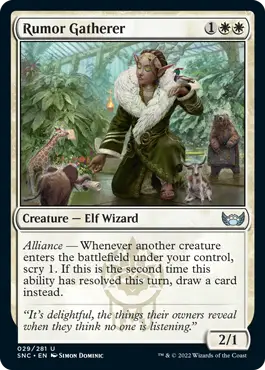


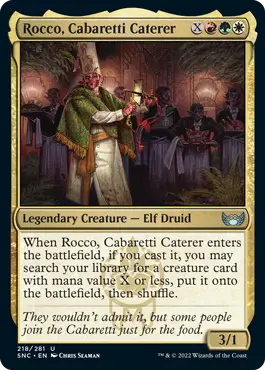


Key Fixing:

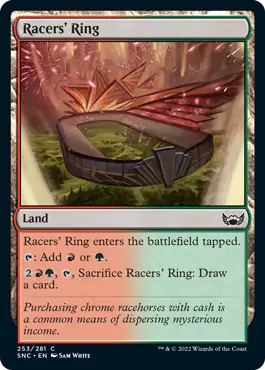
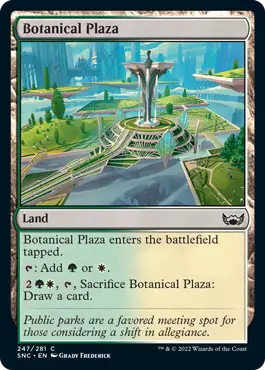
Obscura (Blue-White-Black)
Key Mechanic: Connive – Connive is a triggered ability on creatures that allows them to draw a card, then discard a card. If you discarded a nonland card this way, that creature gets a +1/+1 counter.
Obscura involves creatures with the connive ability. Connive is an interesting mechanic for a multitude of reasons. First, connive is a way to help fix your draw. What I mean by this is that connive can help facilitate what cards you have in hand at any point in the game.
RELATED: Connive – Interactions & Rules Explained
In the early game, if you are missing lands in your hand you can use a card like Raffine’s Informant on turn two to discard a spell, make your Informant a 3/2, and draw closer to your third land drop. Similarly, later on in the game if you’re drawing a lot of lands you can use the connive ability to discard away a land in exchange for an actual spell.
Another great use of connive is how it interacts with cards that care about counters. Take Exotic Pets for example. If you have connive creatures in your deck you can make your unblockable fish tokens 2/2s.
Connive is a powerful mechanic because it gives you decisions to make based on the
Key Cards:

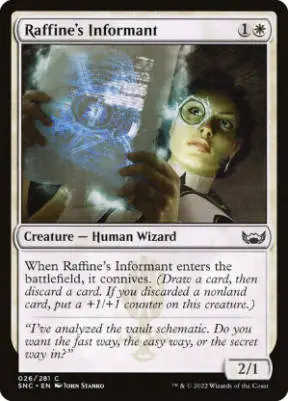
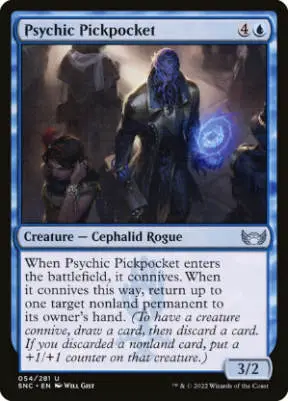
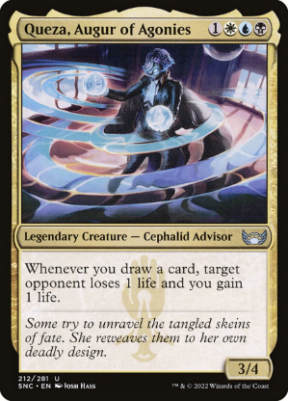


Key Fixing:
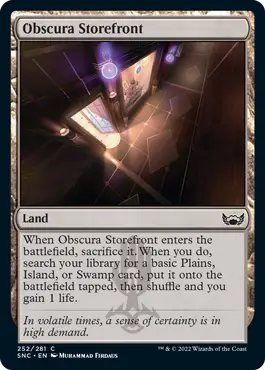
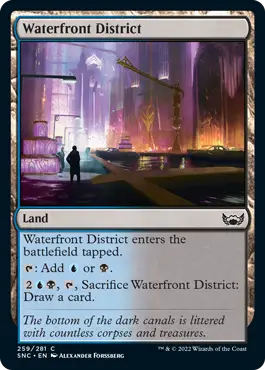
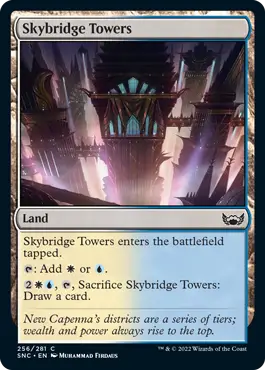
Brokers (Green-White-Blue)
Key Mechanic: Shield Counters – Shield Counters are counters placed on permanents you control. If that permanent would be dealt damage or destroyed, the shield counter is removed instead.
Similar to Obscura, Brokers is another family that cares about counters on creatures. Shield counters prevent your creatures from being destroyed or preventing the next source of damage that would be dealt to them. This makes your creatures both powerful attackers and defenders. There are a couple unique uses for shield counters in Streets of New Capenna Limited.
Related: Shield Counters – How They Work & What They Do
Shield counters have some interesting implications and drawbacks. For example, shield counters help your creatures survive wraths and makes it so your opponent can’t make a favorable trade in combat.
On the flipside, shield counters are also fragile. If you attack with a 3/3 creature that has a Shield counter on it, your opponent could chump block with a 1/1 token, destroying the shield.
Shield is also very powerful with creatures with first strike or effects that grant first strike. Take Disciplined Duelist for example. Disciplined Duelist is a hard creature to block. If you attack with Duelist and your opponent blocks with a 2/2 and 2/3 creatures, you’d actually get to kill the 2/2 and the 2/3 and Duelist would bounce off of each other. Your opponents’ blocks also become incredibly more difficult if they need to play around combat tricks.
One last note on shield counters is how they interact with cards like Kill Shot. Kill Shot can’t destroy shielded creatures, but it is worth noting that if you block with a creature to remove a shield counter in combat, you can cast Kill shot in the post-damage step to destroy that creature.
Key Cards:
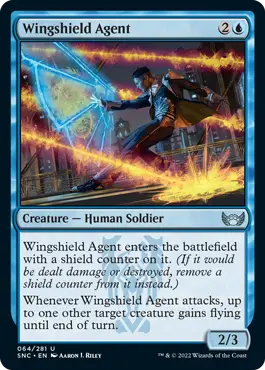

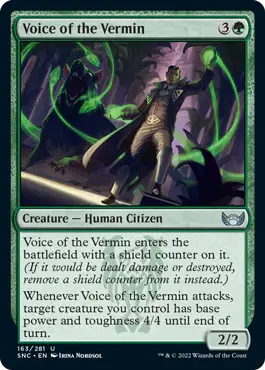



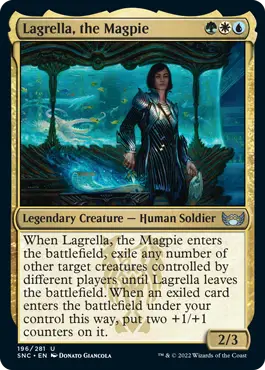
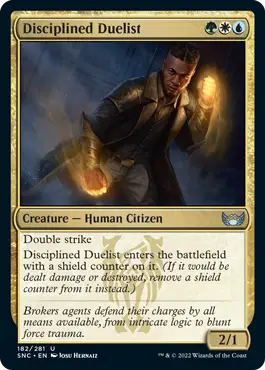
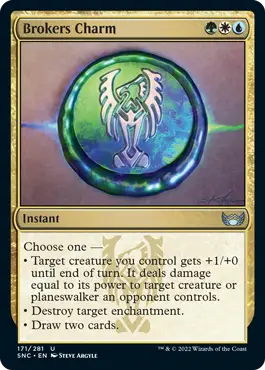
Key Fixing:
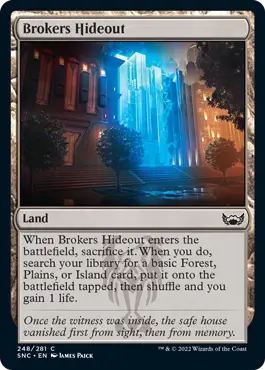
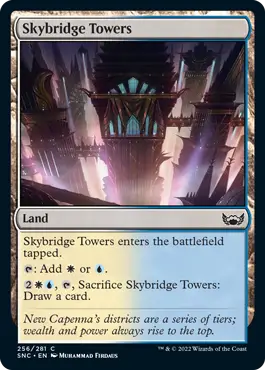
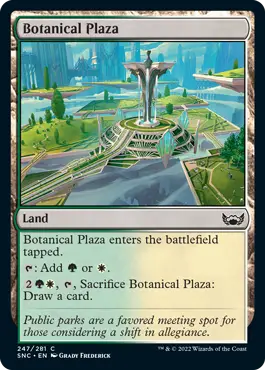
Riveteers (Black-Green-Red)
Key Mechanic: Blitz – Blitz is an alternate casting cost for creatures. When you blitz a creature into play, it gains haste and when it dies, you draw a card. You sacrifice blitz’d creatures at the beginning of the next end step.
Riveteers revolves around the new mechanic, blitz. Blitz is a strong way to get in fast damage with a creature, at the cost of having to sacrifice that creature at the end step. This is powerful for a few reasons but also a bit fragile.
Blitz is strong in that you can get in surprise damage or put enough pressure on to quickly kill your opponent. You should be blitzing in creatures more towards the later parts of the game where you have good attacks. You don’t want to blitz creatures in early because your opponent can simply take the damage and you run the risk of putting yourself at a
RELATED: Blitz Mechanic Explained
Blitz can synergize well with some of the cards in Maestros (see below). You can use cards that benefit from sacrificing creatures on your blitz creatures that will die at the end of the turn anyway. Since blitz reads that you draw a card whenever the creature dies, you don’t miss out on any value by sacrificing your blitz’d creatures to cards in your second main phase.
Riveteers is definitely an aggressive strategy, but you should be mindful of when to use blitz to get in enough points of damage. Blitz also puts pressure on your opponent to make tough decisions when attacking, since they could die unexpectedly to the wrong blitz card.
Key Cards:
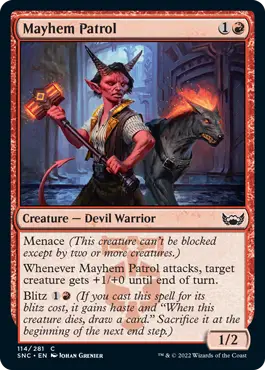
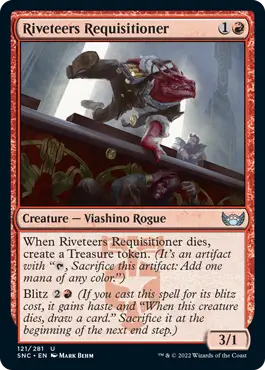
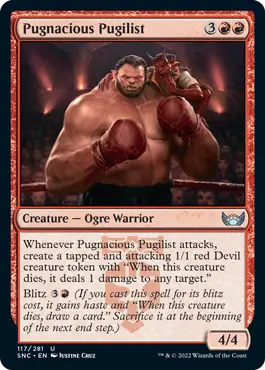
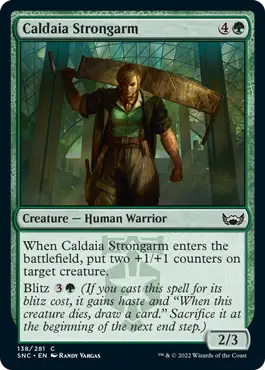
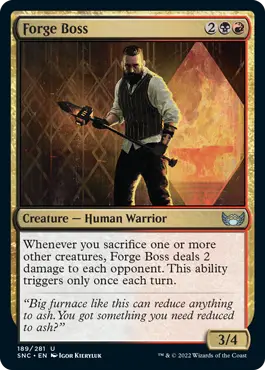
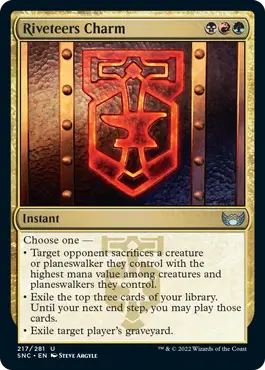
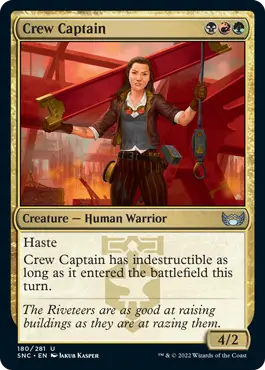
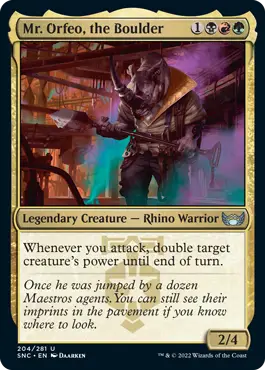
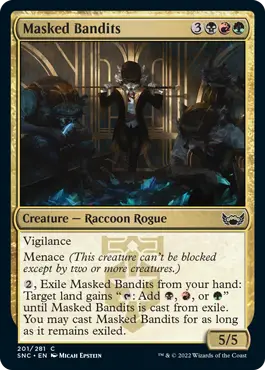
Key Fixing:
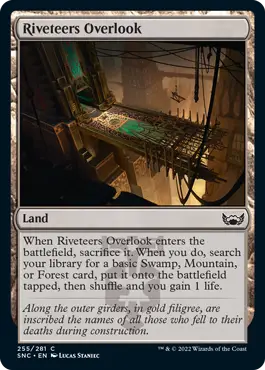
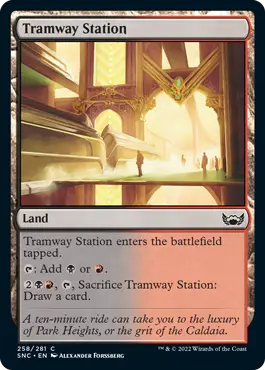
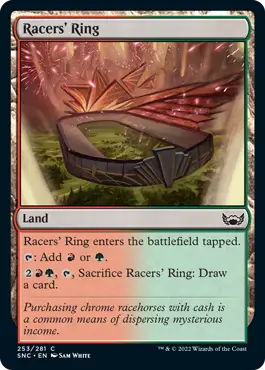
Maestros (Blue-Black-Red)
Key Mechanic: Casualty – Casualty allows you to copy select instants and sorceries with this ability, in addition to sacrificing a creature with a certain power. For example, a card with casualty 2 would allow you to get a copy of that spell if you sacrifice a creature with power 2 or greater.
Maestros is one of the trickier decks to draft in Streets of New Capenna. Maestros revolves around sacrificing creatures to get an additional copy of a spell with casualty. This is a tough mechanic to evaluate because how good your casualty cards are depends on what exactly you’re sacrificing to them.
RELATED: Casualty – How It Works Explained
For example, one removal spell that’s great in Maestros strategies in Sleep with the Fishes. This removal spell locks down one of your opponent’s creatures and gives you a 1/1 unblockable fish token. While the unblockable damage may be relevant, this removal spell actually gives you fuel to cast your casualty cards.
Cards like Corrupt Court Official, with enter the battlefield abilities, are also useful. Paying two mana for a 1/1 that makes your opponent discard a card is somewhat weak. However, utilizing the 1/1 creature later on for a casualty spell helps power up your strategy.
Typically you do not want to be sacrificing tangible creature cards to your casualty spells – you’d rather be sacrificing insignificant tokens or creatures instead.
All in all, Maestros isn’t the most aggressive strategy. It’s a deck that will utilize multiple pieces to pull ahead an advantage against your opponents. Be mindful when drafting this deck of what casualty cards you’re taking and exactly how many sacrifice outlets you have to make sure you’re doubling up on your spells.
Key Cards:
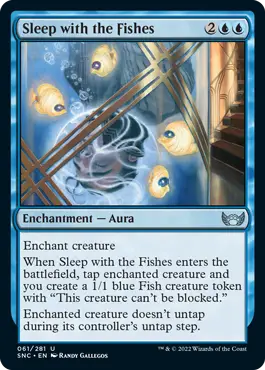
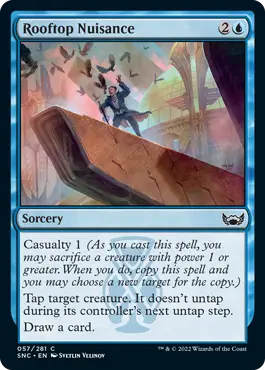
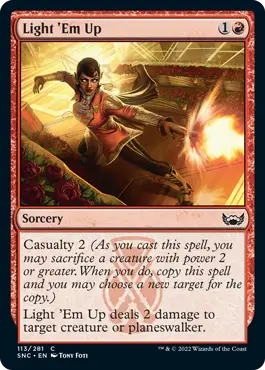
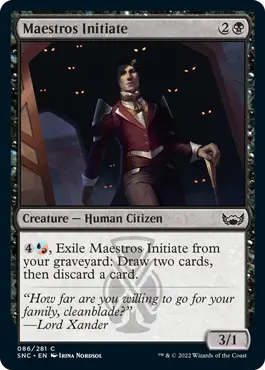

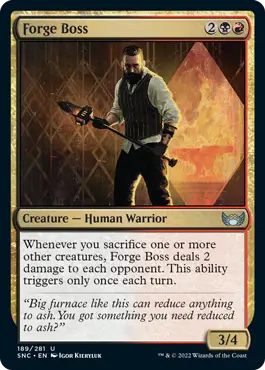


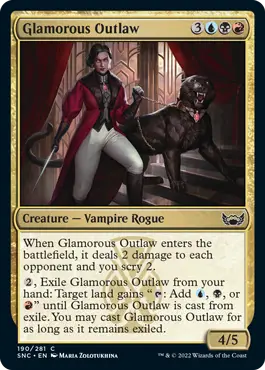
Key Fixing:


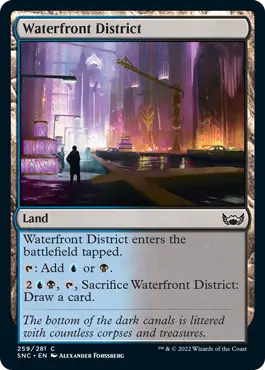
Can I Draft Two Color Decks?
The short answer is, yes! One really interesting aspect of New Capenna draft is that even though it’s a multicolored set, there are actually five very strong two-colored strategies.
The five color pairs revolve around allied colors (Blue-Black, Blue-Green, Red-Black, Blue-White, and Green-Red). Each has two-color cards in its color pair as well. The benefit to playing these decks is that they are more consistent mana-wise. You can even be a tri-colored deck that is base two-colors. This means you won’t be as split among three colors and you’ll be more consistent as a two-color base deck.
Another benefit to playing two-color decks in New Capenna draft is that you can be more aggressive. Decks like Gruul (Red-Green) and Selesnya (Green-White) can assemble powerful creatures early in the game to put a fast clock on the opponent. Let’s dive into the specifics of each of these five archetypes.
What are the Two Color Decks of Streets of New Capenna Draft?
Dimir (Blue-Black)
Dimir revolves around assembling five cards of different mana costs in your graveyard for beneficial effects. You can use cards to mill yourself to power up your threats. Take a look at Snooping Newsie and Sewer Crocodile. These cards are not too exciting at face value. However, a 3/3 lifelinker for two mana and a 4/6 for six mana that can be made unblockable for one mana are big game.
One important note about playing Dimir in New Capenna draft is that you self-mill a lot of cards over the course of a game. Similar to Maestros, you may consider playing more than 40 cards just so you don’t lose the game to milling out your deck.
Another key thing to keep in mind when drafting this deck is mana costs. The sacrifice lands are good in this strategy since they have a mana cost of zero. Since you usually draft multiple cards at two, three, and four mana cost, consider adding cards with mana value one, five, and six so you can hit five diverse mana costs in your graveyard.
Key Cards:
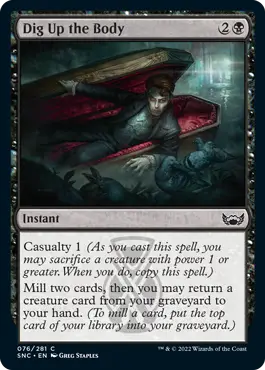
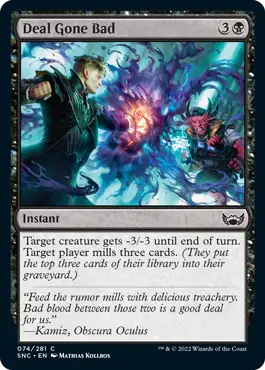
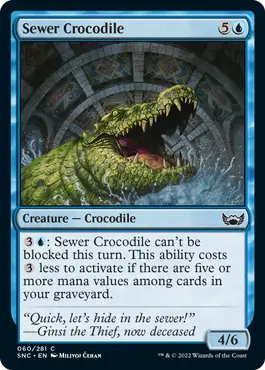

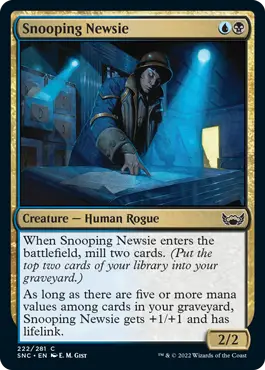
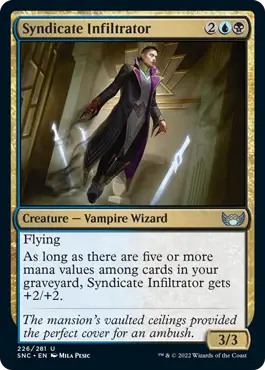
Key Fixing:
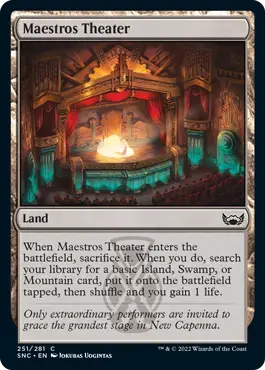

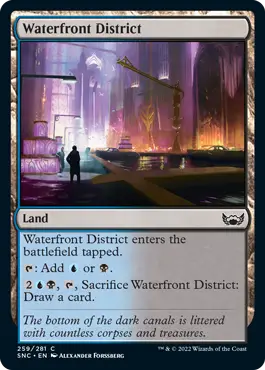
Gruul (Red-Green)
Gruul revolves around cards that utilize treasures. You can use treasures for a variety of different effects for cards in Gruul’s colors, such as Stimulus Package and Jetmir’s Fixer. Gruul decks are usually more aggressive and aim to put powerful creatures into play. You can also play a variety of combat tricks and removal spells to push through the last points of damage.
Key Cards:
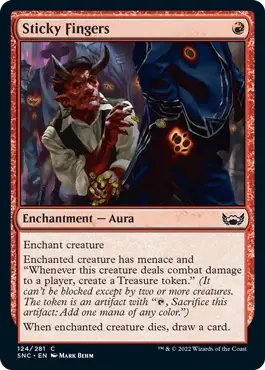





Key Fixing:

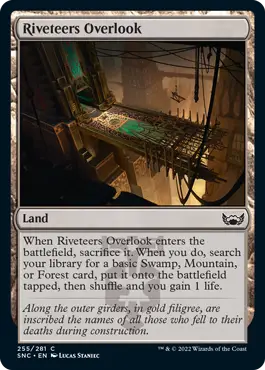
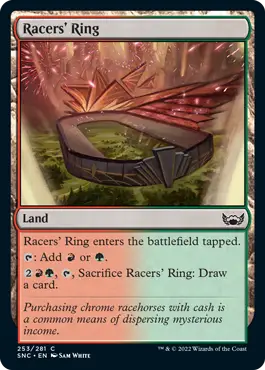
Selesnya (Green-White)
Selesnya is all about the citizen sub-theme. Utilizing this creature type you can find a variety of unique pay-offs. The strongest of these cards is undobutely Civil Servant. A 2/3 for only two mana is a great rate, but this creature can put early pressure on with another citizen creature while also gaining life.
Angelic Observer is another great beneficiary of having multiple citizens, allowing you to play an early aggressive flying creature.
Key Cards:
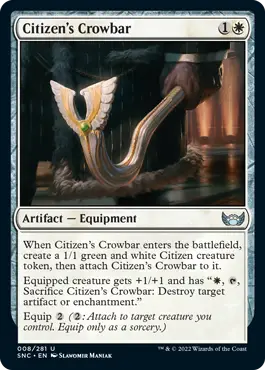
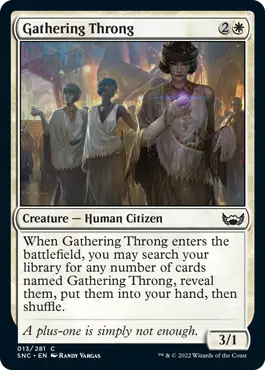
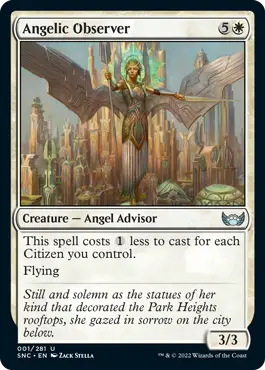



Key Fixing:
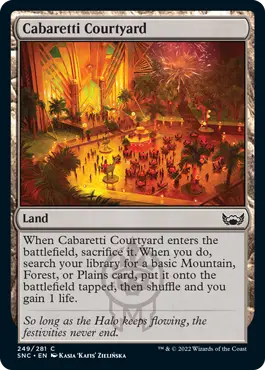

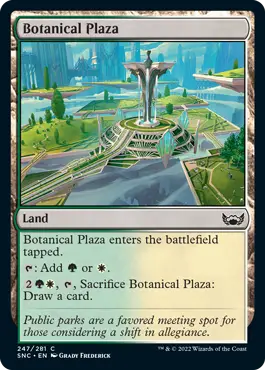
Rakdos (Red-Black)
Similar to Maestros, Rakdos has a sacrifice subtheme. You want to look out for cards like Forge Boss and Body Dropper, which gain beneficiary effects from sacrificing creatures.
Rakdos is great at utilizing some of the Maestros cards, such as Light ‘Em Up. Another thing to look out for when drafting Rakdos is finding creatures with good “enter the battlefield” or “death” triggers. You want to sacrifice creatures that have these sorts of effects to maximize the value out of them.
Rakdos cards also synergize well with Riveteers’ blitz cards. Any cards with the blitz ability that sacrifices on end step is great with Body Dropper and Pyre-Sledge Arsonist.
Key Cards:

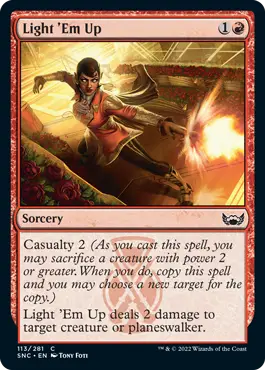



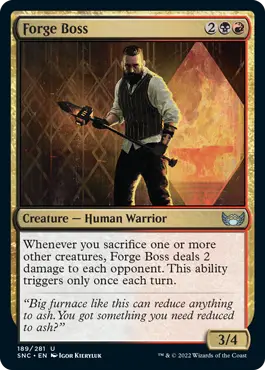
Key Fixing:
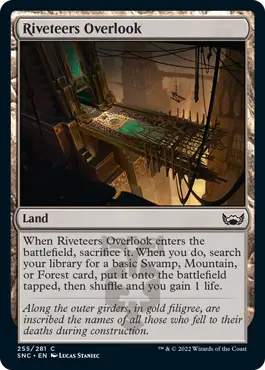
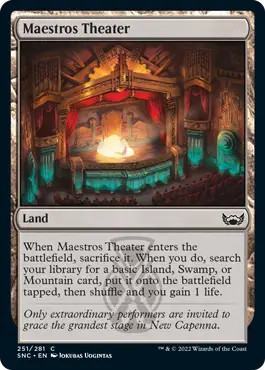

Azorius (Blue-White)
Lastly, we have Azorius. Azorius is first and foremost a “Blue-White Flyers” deck. This is a classic Magic Limited archetype that is all about putting on pressure with evasive flying creatures while keeping the ground boardstate locked down.
Cards like Angelic Regulator and Exotic Pets can provide big tempo swings with hard to block creatures. You can also use spells like Majestic Metamorphosis and Rooftop Nuisance to attack your opponent with surprise points of damage or delay their plan. This archetype is all about knowing when to attack and how to effectively prevent your opponent killing you before you win the game.
Key Cards:

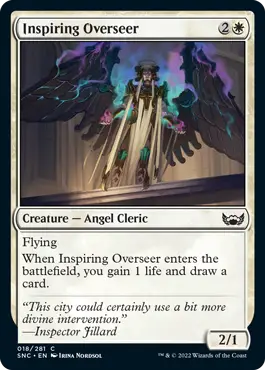
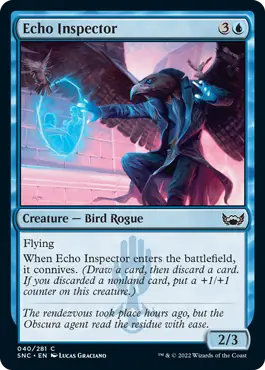
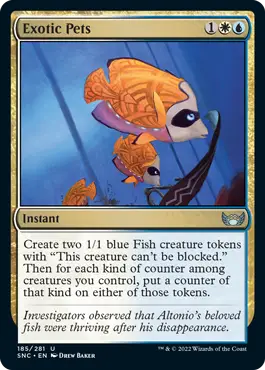
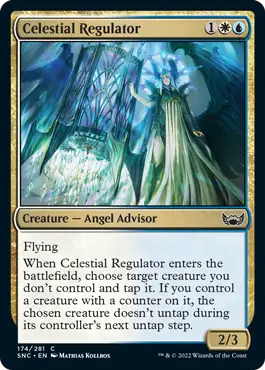

Key Fixing:


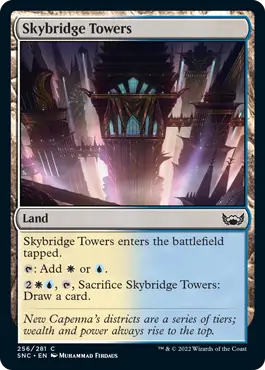
In conclusion, these five strategies are consistent and can be quite fast. It’s important to note that if you’re in a two color combination you should be looking out for cards that synergize well from both families that two color combination shares.
If you’re Azorius you’ll have a counters matter sub-theme since you’re at the crossroads of Brokers and Obscura. If you’re Rakdos you’re in between Maestros and Riveteers, which both revolve around sacrificing creatures. Keep an eye out on how your color pair can benefit from these shared synergies.
Can I Go Five Colors?
This is a tough question to answer. In Sealed, for example, it’s arguably somewhat easy to go five colors. This is due to the fact that you have lots of fixing, powerful cards in multiple colors, and the games go longer on average. While you can’t always go five colors in Sealed it’s certainly a consideration if you have powerful bomb cards in different colors.
It’s worth noting that you shouldn’t prepare to play a certain color combination before a Sealed tournament begins. At the end of the day, a good rule of thumb is that you want to play your best colors that provide an advantage for you, no matter what colors they may be in.
Draft is a much different story. Due to the aggressiveness of New Capenna draft it can be difficult to put together a consistent five color deck. For example, if your opponent starts the game with a turn one Expendable Lackey, turn two Raffine’s Informant, turn three Obscura Initiate, you’re not going to be able to react fast enough.
The weakness of playing more colors is that you’re using your first couple of turns to play tapped dual lands and using the cycle of exile creatures to fix your mana.
The Key to Drafting Five Color Decks
You want cards that can provide good defense. If you’re a five color deck, your deck will usually be on a higher power level than your opponent’s, albeit less consistent. If you take a good chunk of damage in the beginning of the game, cards like Snooping Newsie and Civil Servant can regain that life back later on.
Cards like Echo Inspector help you look for your powerful cards while also providing a tough creature to attack into. Finally, removal spells and “wrath” effects can help you turn the tide in the game you were behind in. “Wrath” effects refer to cards that say “destroy all creatures” or “deal damage to all creatures.”
Lastly, it’s important to note you’ll need some of the cycle of exile creatures to fix your mana. Out of this cycle I really like Glamorous Outlaw, since it has five toughness. There aren’t many creatures at common and uncommon with five or more power, so this creature is hard for your opponent to attack through. In addition, the scry 2 effect from Outlaw can help you smooth out your draw in the late game and find the cards you need to pull ahead.
What is the Best Deck in New Capenna Draft?
While the format is still very fresh, it’s worth noting what players are having success with early on and what color pairs look the strongest. Out of the ten two and three color combinations you can draft in this set (excluding four and five color builds) the strongest color pair is most likely Azorius (Blue-White).
This is surprising since Streets of New Capenna is a tri-colored based set, but Azorius has some of the best on-rate cards at common and uncommon, as well as some of the best combat tricks and disruption spells. Let’s take a closer look.
First off, Blue and White have some of the most efficient creatures at common in this set.

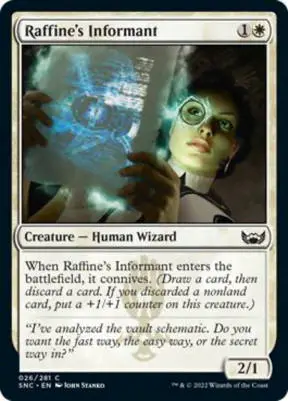
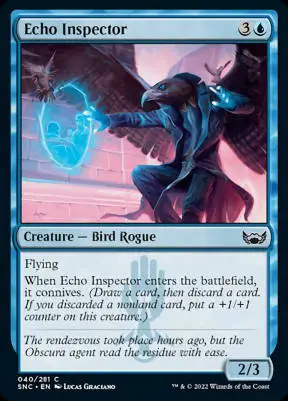
These three cards are all fantastic at what they do: apply decent pressure while fixing your draw. Angelic Overseer replaces itself while Raffine’s Informant can help smooth out your draw and provide fast early pressure with a turn two three-power attacker.
Related: Obscura Operation Upgrade
Echo Inspector by itself is just a very powerful card. Four mana for a 3/4 flying creature is a fantastic rate historically, and the fact that it can either pitch an unwanted land from your hand for a new card, or help you get to your fifth land drop is very important. Connive in Azorius is also great because you can discard cards that can be utilized from your graveyard efficiently, such as Expendable Lackey.
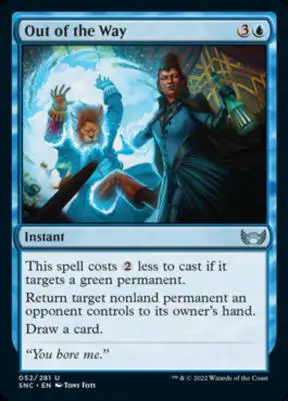
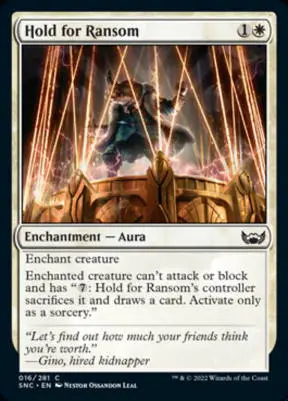
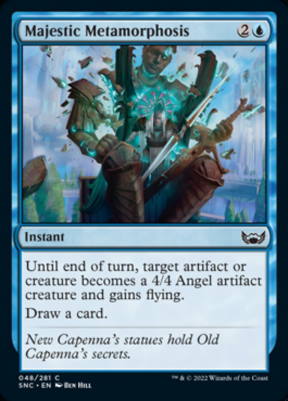
Next, Azorius has great removal and disruption at common and uncommon. Majestic Metamorphosis is fantastic at blowing your opponent out in combat. It’s especially powerful with creatures with shield counters or +1/+1 counters from connive. You can also get in three extra damage with an unblockable fish token.
Out of the Way, Rooftop Nuisance, and Run Out of Town are great ways to out-tempo your opponent, locking down their creatures while you attack. Hold for Ransom is a great removal spell that is unlikely to get sacrificed in Draft.
Overall I’m very happy to start my New Capenna draft Blue-White if the colors are open. If you don’t end up in just straight Azorius you can find fixing and splash some of the better Green or Black cards as your third color.
End Step
Streets of New Capenna is shaping up to be a fantastic Limited format. With multiple viable decks in Draft and a grindy Sealed format, it’s a set that will truly test your skill as a Limited player. While there are colors that definitely seem more powerful than others, it’s still early in the format to jump to any final conclusions. I hope this article gave you some insight into how the set operates and how you can successfully navigate through your next MTG Arena event or in-person tournament.
